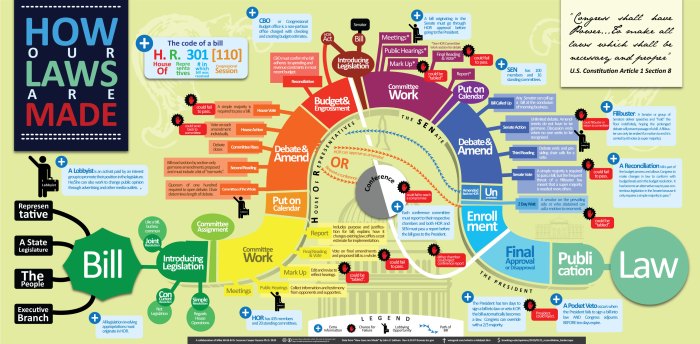
How many laws are there in the us – How many laws are there in the United States? It’s a question that seems simple enough, but the answer is surprisingly complex. The sheer volume of laws, spanning federal, state, and local levels, makes pinpointing an exact number a daunting task. From the Constitution to federal statutes, state constitutions, and local ordinances, the legal landscape of the US is vast and ever-evolving.
This intricate system, while seemingly overwhelming, is a testament to the democratic principles that guide our nation. It’s a system that reflects the diversity of our population and the multitude of issues that affect our lives. Understanding the sources and evolution of US law is crucial for any citizen who wants to navigate this complex legal environment and participate actively in our democracy.
The Complexity of Counting US Laws
It’s a common question: how many laws are there in the United States? Surprisingly, there’s no easy answer. The sheer volume and complexity of the legal system make it nearly impossible to arrive at a definitive number.
The United States has a multi-layered system of government, with laws created at the federal, state, and local levels. This creates a vast and intricate web of regulations that governs every aspect of life.
Different Types of Laws
The different levels of government each have their own unique ways of making laws. Here are some examples:
- Statutes: These are laws passed by legislatures at the federal, state, and local levels. For example, the federal government has passed statutes on topics like civil rights, environmental protection, and healthcare. States have statutes governing areas like education, transportation, and criminal justice. Local governments often pass ordinances on issues like zoning, noise pollution, and parking.
- Regulations: These are rules and guidelines created by government agencies to implement statutes. For instance, the Environmental Protection Agency (EPA) issues regulations to enforce the Clean Air Act. The Food and Drug Administration (FDA) creates regulations to ensure the safety of food and drugs.
- Ordinances: These are laws passed by local governments, such as city councils or county commissions. Ordinances typically cover matters of local concern, such as zoning, building codes, and public safety.
- Executive Orders: These are directives issued by the President of the United States that have the force of law. Executive orders can be used to implement existing laws, create new policies, or change government operations.
Sources of US Law

The United States legal system is a complex and multifaceted structure, drawing its authority from various sources. Understanding these sources is essential for comprehending the application and interpretation of laws in the country.
The Constitution
The Constitution of the United States is the supreme law of the land. It establishes the framework for the federal government and defines the basic rights of citizens. The Constitution is the foundation upon which all other laws are built. It Artikels the powers of the federal government, the relationship between the federal government and the states, and the fundamental rights of citizens. The Constitution also establishes the three branches of the federal government: the legislative, executive, and judicial branches.
Federal Statutes
Federal statutes are laws passed by the United States Congress. These laws cover a wide range of subjects, including commerce, taxation, immigration, and criminal justice. The process of enacting federal statutes involves a series of steps, including introduction of a bill, debate and amendment, and ultimately a vote by both the House of Representatives and the Senate. The President must then sign the bill into law.
State Constitutions
Each state in the United States has its own constitution, which establishes the structure and powers of the state government. State constitutions are subordinate to the U.S. Constitution, but they can provide more specific rights and protections for citizens within their respective states. Similar to the U.S. Constitution, state constitutions are typically amended through a process that requires a vote by the state legislature and the people.
State Statutes
State statutes are laws passed by state legislatures. These laws cover a wide range of subjects, including education, healthcare, and environmental protection. State statutes are subject to the U.S. Constitution and the relevant state constitution.
The Role of the Judiciary
The judiciary plays a critical role in interpreting and applying the law. Courts at all levels, from state trial courts to the Supreme Court, are responsible for resolving disputes and ensuring that laws are applied fairly and consistently. The judiciary’s role in interpreting the law is crucial, as it ensures that the law keeps pace with evolving social norms and values.
Types of Laws and Their Sources
| Type of Law | Source |
|---|---|
| Constitutional Law | U.S. Constitution and state constitutions |
| Statutory Law | Federal statutes and state statutes |
| Administrative Law | Regulations issued by federal and state agencies |
| Common Law | Judicial decisions (precedents) |
The Evolution of US Law
The legal system of the United States has evolved significantly over time, shaped by historical events, societal changes, and philosophical shifts. This evolution has resulted in a complex and multifaceted legal framework that continues to adapt to contemporary challenges.
Historical Development of US Law
The legal history of the United States can be traced back to the colonial era, with influences from English common law, Roman law, and indigenous legal traditions. Early colonial laws often reflected the practices of their respective European origins, with modifications to suit local conditions. The American Revolution and the adoption of the Constitution marked a pivotal turning point, establishing a new system of government and a framework for the development of a distinct American legal tradition.
- English Common Law: The foundation of the American legal system is rooted in English common law, which developed through judicial precedents and customary practices. This system emphasized the importance of stare decisis, the principle of following previous rulings in similar cases.
- The Constitution: The US Constitution, adopted in 1787, established a framework for the federal government and defined the fundamental rights of citizens. The Bill of Rights, added in 1791, further guaranteed specific freedoms, including freedom of speech, religion, and the press.
- Landmark Supreme Court Decisions: Throughout history, the Supreme Court has played a crucial role in shaping the legal landscape through its landmark decisions. These decisions have addressed issues such as slavery, civil rights, and the interpretation of the Constitution. Notable examples include *Marbury v. Madison* (1803), which established the principle of judicial review, and *Brown v. Board of Education* (1954), which declared state-sponsored segregation in public schools unconstitutional.
Comparison with Other Legal Systems, How many laws are there in the us
The US legal system is often compared to other legal systems around the world, such as those found in civil law countries like France and Germany. While all legal systems aim to provide a framework for resolving disputes and maintaining order, they differ in their origins, structures, and approaches.
- Civil Law: In civil law systems, legal principles are primarily codified in written laws, known as statutes or codes. Judges rely heavily on these codes when making decisions.
- Common Law: Common law systems, like the US system, rely more heavily on judicial precedents and customary practices. Judges in common law systems have the power to interpret and apply the law, creating new precedents that can influence future cases.
- Mixed Systems: Some countries have mixed legal systems, combining elements of both civil and common law. For example, South Africa has a legal system based on Roman-Dutch law, which incorporates aspects of both civil and common law traditions.
Timeline of Key Legal Events
A timeline of key legal events in US history helps illustrate the evolution of the legal landscape and its impact on society.
| Date | Event | Impact |
|---|---|---|
| 1776 | Declaration of Independence | Established the principles of individual liberty and self-governance, laying the foundation for the development of a distinct American legal system. |
| 1787 | Adoption of the US Constitution | Created a framework for the federal government and established the principle of separation of powers, defining the roles of the legislative, executive, and judicial branches. |
| 1791 | Adoption of the Bill of Rights | Guaranteed specific individual freedoms, including freedom of speech, religion, and the press, shaping the interpretation and application of the Constitution. |
| 1803 | *Marbury v. Madison* | Established the principle of judicial review, giving the Supreme Court the power to strike down laws deemed unconstitutional. |
| 1865 | 13th Amendment to the Constitution | Abolished slavery, marking a significant shift in the legal status of African Americans. |
| 1954 | *Brown v. Board of Education* | Declared state-sponsored segregation in public schools unconstitutional, leading to the desegregation of schools across the country. |
| 1964 | Civil Rights Act | Prohibited discrimination based on race, color, religion, sex, or national origin, advancing civil rights for marginalized groups. |
| 1973 | *Roe v. Wade* | Recognized a woman’s right to abortion, sparking ongoing debate and legal challenges. |
The Impact of Laws on Society

Laws are the bedrock of any organized society, providing a framework for order, justice, and the protection of individual rights. They serve as a powerful tool for shaping societal norms and values, influencing how people behave, interact, and view the world around them.
The Role of Laws in Shaping Societal Norms and Values
Laws act as a mirror reflecting the prevailing values and beliefs of a society. They codify what is considered acceptable or unacceptable behavior, establishing a moral compass for citizens. For instance, laws against discrimination based on race, religion, or gender reflect a societal shift towards inclusivity and equality. Similarly, environmental protection laws demonstrate a growing awareness of the need to safeguard our planet for future generations.
Examples of Laws Influencing Social Change and Progress
Throughout history, laws have played a pivotal role in driving social change and progress. The landmark Civil Rights Act of 1964, for example, outlawed discrimination based on race, color, religion, sex, or national origin, significantly advancing the cause of racial equality in the United States. The Americans with Disabilities Act (ADA) of 1990, prohibiting discrimination against individuals with disabilities, transformed the landscape of accessibility and inclusion. These laws, along with numerous others, have brought about profound changes in American society, paving the way for a more just and equitable nation.
The Impact of Specific Laws on American Life
| Law | Area of Impact | Impact |
|---|---|---|
| Civil Rights Act of 1964 | Civil Rights | Eliminated discrimination based on race, color, religion, sex, or national origin in employment, public accommodations, and education. |
| Americans with Disabilities Act (ADA) of 1990 | Accessibility and Inclusion | Prohibits discrimination against individuals with disabilities in employment, public accommodations, transportation, and communication. |
| Affordable Care Act (ACA) of 2010 | Healthcare | Expanded health insurance coverage to millions of Americans, provided subsidies to help people afford coverage, and implemented reforms aimed at reducing healthcare costs. |
| No Child Left Behind Act (NCLB) of 2001 | Education | Focused on improving educational standards and accountability, requiring states to develop standardized tests and hold schools accountable for student performance. |
Wrap-Up

The United States’ legal system is a testament to the ongoing dialogue between the people and their government. It’s a dynamic system that reflects our history, values, and aspirations. While the exact number of laws may remain elusive, the importance of understanding their origins, evolution, and impact on our lives remains paramount. Whether you’re a concerned citizen, a student of law, or simply curious about the intricacies of our legal framework, exploring the world of US law is a journey that promises to be both enlightening and empowering.
FAQs: How Many Laws Are There In The Us
What are the main sources of US law?
The primary sources of US law include the Constitution, federal statutes, state constitutions, state statutes, and judicial decisions.
How can I find specific laws?
You can access legal databases like Westlaw or LexisNexis, or use online resources like the United States Government Publishing Office (GPO).
Is there a single, authoritative source for all US laws?
No, due to the federal structure of the US government, laws are enacted and codified at different levels, making a single source for all laws impossible.
How often are US laws updated or changed?
Laws are constantly being updated and amended through legislative action, judicial decisions, and executive orders. The frequency of changes varies depending on the specific area of law.


